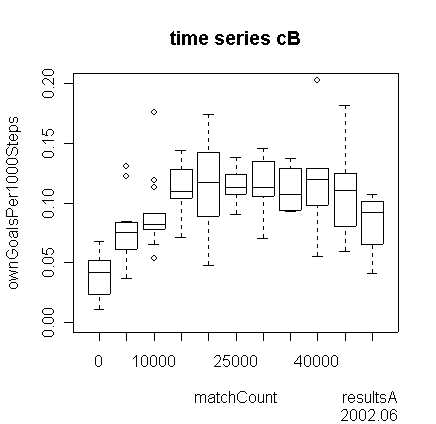| Raw data | A |
| Version | vsoc 0.04-vsoc 0.05a |
| Class | vsoc.camps.goalgetter.GG1TestA |
| Project homepage | http://vsoc.sourceforge.net |
To find an optimal structure for the ANNs is a task where no simple rules exist. So it is mainly a process of try and error. Finding out what kind of feed forward net could be optimal for soccer playing clients this test was executed.
The test uses multiple feed forward nets. They differ in the number of layers and in the numbers of connections between this layers. The number of connections is defined by the probabillyity of connections between two arbitrary nodes of this layers.
The following nets where used.
| name | description | connections |
|---|---|---|
| c | Standard net | Numbers of neurons per layer: 32 (input layer), 24, 18 (output layer) Connection probabilities between layers: (1->0 : 90%) (2->0 : 30%) (2->1 : 90%) |
| cA | A net with no intermediate layer | Numbers of neurons per layer: 32 (input layer), 16 (output layer) Connection probabilities between layers: (1->0 : 100%) |
| cB | A net of the same complexity as the standard net but with another seed | Seed: 987234: Numbers of neurons per layer: 32 (input layer), 24, 18 (output layer) Connection probabilities between layers: (1->0 : 90%) (2->0 : 30%) (2->1 : 90%) |
| cC | A net of the same complexity as the standard net, but with no connections from the output- to the inputlayer. | Numbers of neurons per layer: 32 (input layer), 24, 18 (output layer) Connection probabilities between layers: (1->0 : 90%) (2->0 : 0%) (2->1 : 90%) |
| cD | A net with less connections than the standard net | Numbers of neurons per layer: 32 (input layer), 24, 18 (output layer) Connection probabilities between layers: (1->0 : 50%) (2->0 : 10%) (2->1 : 50%) |
| cE | A net with two intermediate layers and the same connection complexity as the standard net | Numbers of neurons per layer: 32 (input layer), 26, 22, 18 (output layer) Connection probabilities between layers: (1->0 : 90%) (2->0 : 30%) (2->1 : 90%) (3->0 : 10%) (3->1 : 30%) (3->2 : 90%) |
| cF | A net with two intermediate layers and less connection complexity than cE | Numbers of neurons per layer: 32 (input layer), 26, 22, 18 (output layer) Connection probabilities between layers: (1->0 : 50%) (2->0 : 10%) (2->1 : 50%) (3->0 : 5%) (3->1 : 10%) (3->2 : 50%) |
Attention: The fitness function contains an error. OwnGoalFactor and otherGoalFactor are multiplied with the wrong values. The result of this is that players of this simulation try to score own goalrather than goals. This is a little bit confusing but does not really influence the results. Whenever you see ownGoals it means otherGoals and vice versa.

The amount of observations seems to be sufficient. The simpler nets have more observations as they perform faster and by that play more matches.

The most important result of this is that the net with no intermediate layers (cA) performs best. Although the mean goal rate is not much higher than for other nets, most of the best performing players are of that class. Intermediate layers seem not to enhance the performance of scoring goals.
The nets with less connections between layers seem to reach the same results than the fully connected ones (c - cB - cD, cE - cF). Only the loss of direct connections from input to output layers seems to have a negative effect on nets with intermediate layer.
The time series should ensure that runs that have a poor average performance do not only perform bad at the beginning (the first 50000 matches that where observed in that run) but might be better than the others in longer runs.

The frequency table shows that the complex nets (cE, cF) do not have many observations for late matches (matchCount > 35000). Therefore the variance seems to be low for these matches. You also may not trust tendences they indicate as they are produced by only very less observations.

A saturation seems to be reached at 40000 matches at a value of 0.13 goals per 1000 steps.

A saturation seems to be reached at 30000 matches at a value of 0.15 goals per 1000 steps.

Saturation seems to be reached after 20000 matches at a value of 0.1 goals per 1000 steps.

Saturation seems to be reached after 20000 matches at a value of less than 0.1 goals per 1000 steps.

Saturation seems to be reached after 10000 matches at a value of 0.1 goals per 1000 steps with relative great variance.

Saturation seems to be reached after 20000 matches at a value of less than 0.1 goals per 1000 steps.

Saturation seems to be reached after 10000 matches at a value of less than 0.1 goals per 1000 steps.
The net with no intermedate layers (cA) seems to perform best and no signs indicate that it might be outreached by any of the other nets in longer runs. For feed forward nets it could be interesting to figure out if nets with no intermedate layers but less connections than cA could produce reasonable results. For theses nets diffrent values of seed schould be explored, as they might influence the results.